Soft wall panels: design options and installation methods

Soft wall panels have a special sophistication and charm among the variety of finishing options. They can be found infrequently, however, such an interior always looks unusual. The material allows you to emphasize individuality, to focus on one of the walls, to bring an atmosphere of elegant luxury into the room.
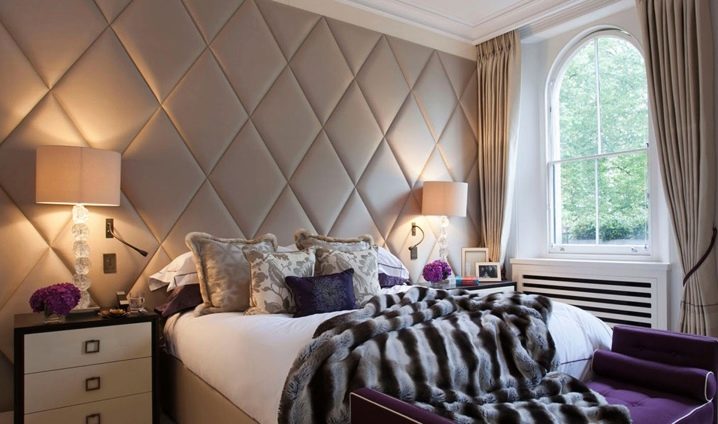
Peculiarities
Soft wall panels are designed for interior decoration. This is a voluminous material that is distinguished by its texture and original appearance. As a rule, there are products that are manufactured in a factory, although they can be made with your own hands.
The panels consist of several layers and have the following structure:
- the foundation made of durable sheet materials with good adhesion rates, for example, polyvinyl chloride. The base thickness is 5–8 mm;
- middle layer - this is the so-called filling, which is foam rubber, synthetic winterizer or polyurethane;
- outer decorative layer - these are stretched artificial or natural leather and fabrics. In addition, the outer layer is treated with special compounds that ensure the hydrophobicity of the coating, its resistance to sunlight and high temperatures.
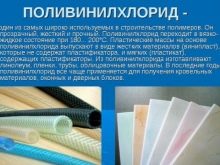
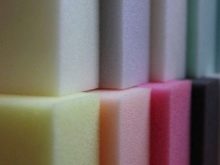

Advantages and disadvantages
Soft wall panels fit well into any type of interior, the main thing is to choose the appropriate solution. They allow you to create an elegant interior, add notes of aristocratic luxury to it. It is important that the panels are universal - they are suitable for living quarters, they are used for upholstery in cafes, cinemas and other establishments.
Among the advantages are the following:
- sound and heat insulation effect;
- decorative functions - this detail of the interior will definitely be remembered by guests and visitors;
- the ability to zone a room without resorting to the use of bulky partitions and screens;
- versatility and the ability to harmoniously combine with different types of finishing materials;
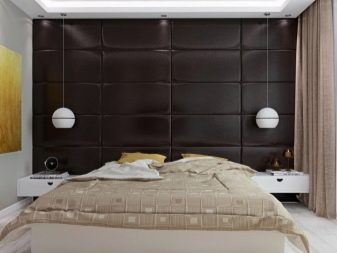
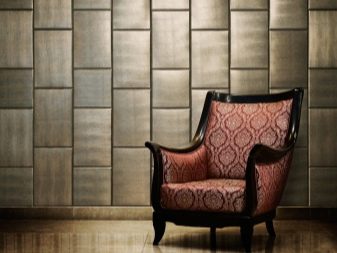
- the ability to hide minor flaws in the wall covering, first of all, differences in height;
- ease of installation;
- resistance to deformation - after pressing, the material immediately takes on its former shape;
- environmental friendliness and safety of the material - an excellent option for decorating children's rooms;
- ease of use - leather panels are easy to care for.
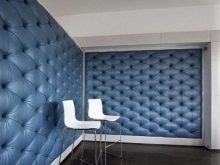
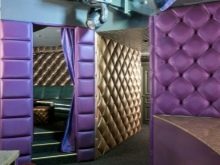
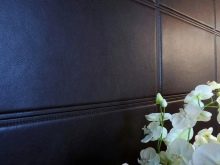
It is fair to say that the cost of the products is quite high.
We must not forget that textile surfaces require special care. Otherwise, they will quickly lose their gloss and attractiveness.
Variety of materials
The panels differ in size: there are both very small (100x100 mm) and rather large (1.5x2.7 m) products. As for the shape, these are mainly squares and rectangles.
Allocate a coating with and without a screed. The latter are usually made on sheets of plywood or hardboard. The carriage coupler is widespread, suggesting the presence of grooves on the surface of the material, into which decorative buttons are sewn. By resorting to a varied arrangement of the latter, it is possible to create authentic reliefs and textured patterns. The classics are squares or rhombuses formed by buttons fixed on certain sections of the fabric.
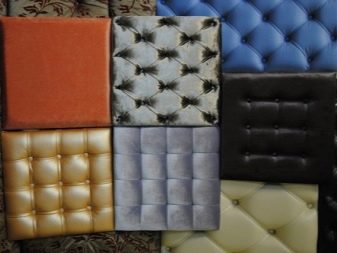
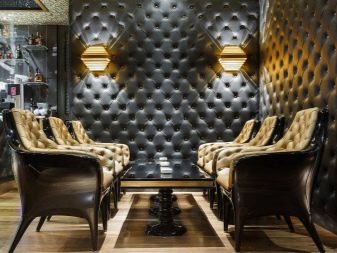
The most attractive carriage coupler looks on a plain leather, velvet, velor and suede coverings.
A special place is occupied by 3D panels, the base of which is usually MDF panels, gypsum or solid wood. They are given an original form. Convex (textured) parts of the base are painted or upholstered with leather or textiles.
Depending on the cladding used, there are such types of products as:
- fabric - covered with velvet, velor or natural fabrics. The main thing is that the material does not stretch, does not fade;
- having a top layer of genuine leather. The most expensive type of material looks good in classrooms, offices, living rooms;
- covered in faux leather, for example, Alcantha. They also look exquisite, while it is often very difficult to find imitation, the material is so similar to natural leather, the easiest to care for.
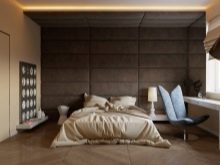
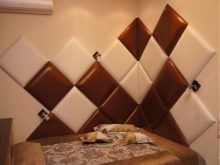

Selection Tips
- For bedroom usually choose lightweight padding panels. They are upholstered in some part of the room, for example, the area above the head of the bed. As a rule, this type of finish matches in tone with the shade of curtains and wallpaper, or, conversely, acts as a contrast. Textile or leather products of calm shades are often chosen for design. Stronger foam and polyurethane products look good and serve for a long time in the living room, in the nursery, as well as in gyms. These types of panels are more voluminous compared to synthetic winterizer.
- For bed child, that is, when the panels perform not only a decorative, but also a practical function, it is better to choose more voluminous foam panels. By placing them on the wall near the bed, you can protect your baby from accidental blows and injuries during sleep.
- In the living room, as in the hallway, leather panels look good, for example, artificial leather panels, as well as velvet, suede counterparts. An important point: they must have increased wear resistance and have antibacterial impregnation.
When buying soft panels, you should give preference to products with a high-quality and wear-resistant top layer.
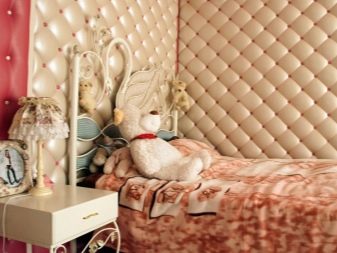
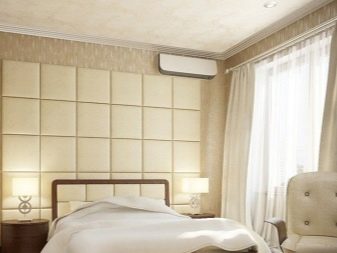
If you decide to make them yourself, then furniture fabrics will be the best choice. Working with leather is quite difficult for a layman. It is also recommended to use an easier-to-use synthetic winterizer as a filler. It will allow you to achieve smooth and uniform surfaces.
When choosing textile panels, it is worth giving preference to those that have antibacterial and antistatic impregnation. The presence of the latter will provide zero static of the product, it will practically not attract dust.
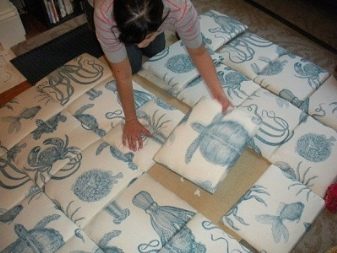
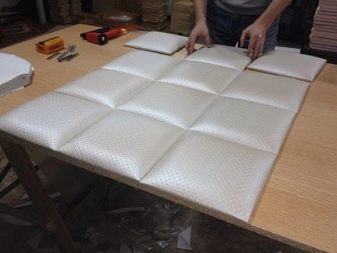
When buying wall panels, like any building materials, preference should be given to products from reputable manufacturers, whose products have established themselves as high-quality and safe.
- One of these is the company Mollemebel, originally engaged in the production of beds, but gradually expanded the range of soft wall materials. Today, under this brand, a variety of textile and leather panels are produced, as well as analogues from Alcantha and other leatherette.
- Domestic products "House of Walls" - these are panels made of suede, leather, alcantha, as well as super-resistant fiber with antibacterial properties, capable of breaking down odors, and also resistant to fire.
- Another Russian manufacturer Molize also earned positive feedback from buyers. Products made of leather, its substitute and textiles comply with European quality standards. It is possible to manufacture panels to order.
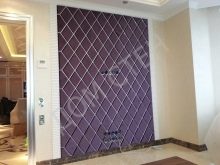
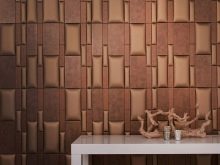

- A wide variety of textile panels can be found from the manufacturer "Soft sign", which produces panels under the Soft Sign brand. Among the most popular coatings are flock, jacquard, velor, velvet and leatherette. Buyers can choose both designer products and implement their own ideas, order for the manufacture of panels according to their own sketches.
- A huge selection of leather panel options is presented in the brand's collections "Parquet Avenue"... It is easy to guess from the name of the company that it is also engaged in the manufacture of floor coverings. This is indeed the case, although today the leading direction of the company's activity is the production of soft wall panels, and the emphasis is on products with leather upholstery.
- Among other worthy manufacturers, buyers mark products LLC "Knerzer Group" and MK "Stroy". Both companies, in addition to making panels, also produce furniture.
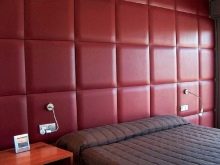
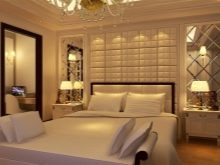
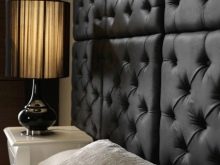
Subtleties of installation
The installation of wall panels is a multi-stage process.
- The first step is, of course, preparatory... The owner of the premises is determined with the size and type of material, calculates the required number of panels, glue and other elements and tools. If you decide to make wall panels with your own hands, then you need to purchase a sheet of plywood, synthetic winterizer or foam rubber, fasteners, furniture fabric. First, panels are cut out of the plywood sheet of the required size, on which they make markings for the screed and fastening systems. Holes are drilled according to the marking.
- The next step is filler preparation. A fragment is cut out of synthetic winterizer or foam rubber, corresponding to the dimensions of the plywood elements. With the help of glue, the filler is connected to the base.
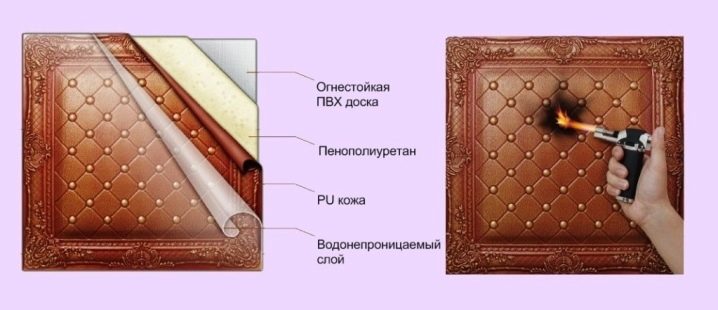
- Next, they begin to tighten the resulting frame with fabric. The size of the fabric to be cut should be equal to the size of the base plus 7 cm on each side (for hem, taking into account the thickness of the backing and filler). A nylon thread is pulled through the existing holes in the filler and the base, the upholstery material is put on the needle and the button is immediately sewn. Repeat the steps for each hole, thereby fixing the top decorative layer. After the last button is sewn, it remains only to bend the edges of the finishing material onto the wrong side of the plywood and secure them with staples using a furniture stapler.
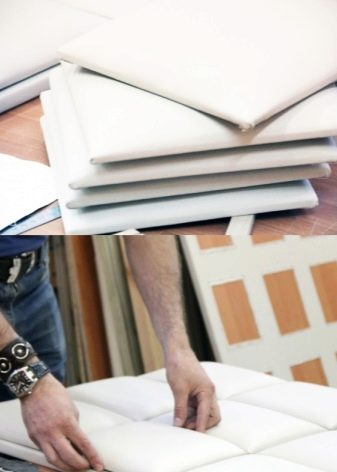
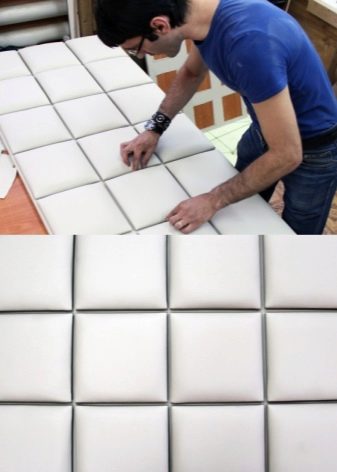
The thickness of the finished structure is determined by the thickness of the base and filler. For large rooms, it is better to take thicker bases - up to 5 mm. For small rooms, it is worth using bases with a thickness of no more than 3 mm, giving preference to smaller panels.
For panels, buttons are used, covered with the same material as the top side of the product.
On sale you can find ready-made kits consisting of material for tight-fitting and the same buttons. You can make your own buttons by purchasing more fabric and cutting it into small pieces of the size of the buttons.
The buttons are covered with fabric, it is more convenient to do this immediately in the process of fixing them.
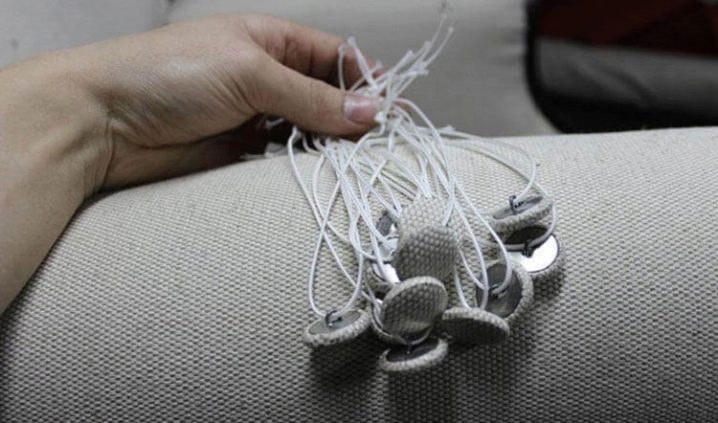
Store-bought or self-made panels can be attached to walls in various ways. Here is an example of step-by-step instructions for the popular frame fixation:
- from wooden slats treated with an antiseptic, a cellular-type frame is mounted, which is fixed on the wall with dowels;
- the cells are filled with foam rubber, which should be fixed with glue;
- the structure is covered with padding polyester, which is fixed with staples at the edges;
- the upholstery is stretched, fixed on the sides of the crate;
- the attachment points are closed with glued decorative tape;
- small carnations are closed with a cloth and hammered along the surface of the decorative layer into the frame slats.
A little tip: in order not to damage the sheathing when hammering in nails, you should use synthetic padding.

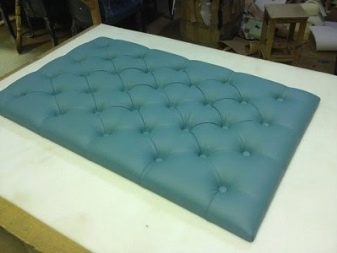
Today on sale you can find panels with locking mechanisms on the back. With the help of them, the products are hung on the crate without requiring fixation with nails. If the panels are small in size and light in weight, and the base is quite strong (load-bearing wall, for example), you can glue the products.
The general process looks like this:
- markings are made on the wall - a plan for fixing the panels;
- glue is applied to the back of the panel along the perimeter and in the center;
- the panel is applied to the wall according to the markings and pressed.
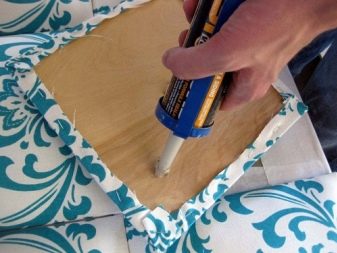
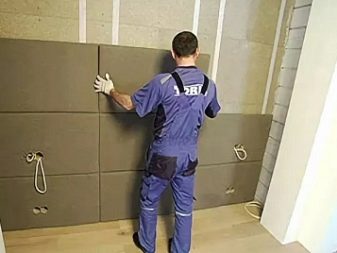
Work can be carried out both from bottom to top and from top to bottom. If a smaller panel is required, it is first disassembled and then sawn or trimmed. The resulting element of suitable size is again covered with padding polyester (foam rubber) and covered with a decorative layer. Since trimmed dimensions are less aesthetically pleasing, it is recommended that you mount them in such a way that you do not have to resort to trimming. This can be done by filling not the entire wall, but its central part, that is, not reaching the corners.
In this case, it is important to ensure that the distance on all sides between the part of the wall decorated with the panel and the corners is the same.
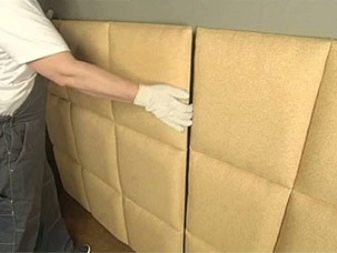
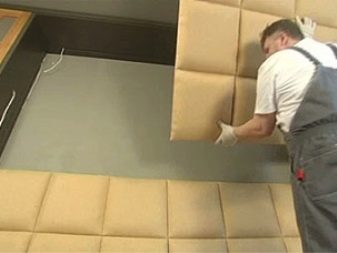
Diluted PVA or liquid nails are used as an adhesive base. If glue gets on the outside of the panel, it should be wiped off immediately. During installation, you must try to prevent glue from getting on the front side. Regardless of the fastening method chosen, it is important to properly prepare the wall panel. All irregularities should be repulsed, communications (pipes, wires) removed, cracks should be eliminated.
If you plan to glue the material, it is better to remove the previous finishing layer, as it may impair adhesion.
Apply a primer in 2-3 coats on a flat, clean and dry wall. It will act as an antiseptic and improve the adhesion of materials.
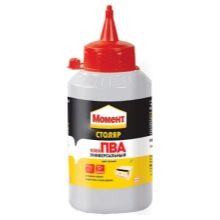
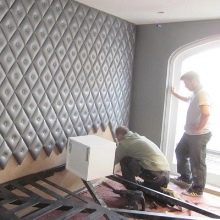

Tips & Tricks
Experts recommend adhering to the following tips when working with soft wall panels:
- when choosing leather wall panels, you should combine them with textured wallpaper, elegant wooden furniture;
- if the task is to zone the room, then the "soft" wall can be continued by partially finishing the ceiling or podium with panels;
- the easiest to care for are models upholstered in artificial leather. Smooth matte leather will prove to be the most durable and easy to use. It can be wiped with a clean dry or slightly damp cloth;
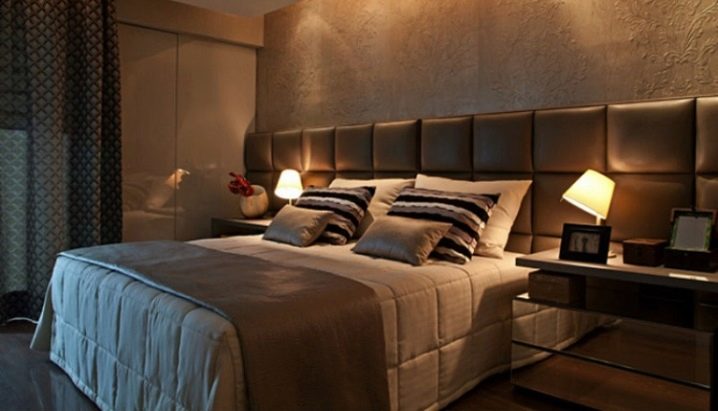
- for leather products, it is better to purchase special care products and polishes. Those that are used to care for upholstered leather furniture are also suitable;
- it is usually sufficient to periodically clean fabric surfaces with a vacuum cleaner using a special nozzle for upholstered furniture;
- it is unacceptable to rub surfaces, use aggressive cleaning agents, as well as products with abrasive particles;
- if liquid gets on the wall panels, immediately blot the stain with a dry clean cloth or rag.
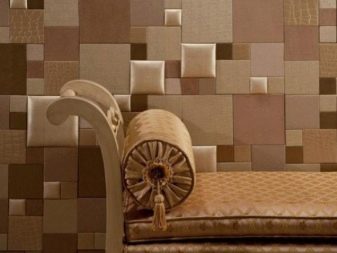

Regarding color, it is worth remembering that the wall panel usually becomes the center of the room.
- For bedroom usually calm beige or light shades are chosen. Such a panel is able to visually expand the room.
- For the living room and cabinet, you can choose and darker shades. Leather elements in coffee, brown, graphite and black shades look respectable.
- For the nursery usually muted light or bright shades are chosen.
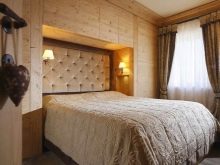
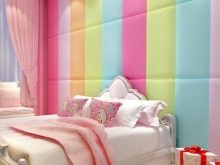
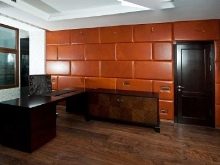
The use of 3D panels, combining different colors, allows you to achieve interesting effects. For example, a panel with a wave-like texture, painted or upholstered with materials in 2-3 shades from dark blue to light aquamarine, creates the illusion of a panel on a marine theme.
It is not at all necessary to upholster the entire surface of the wall with panels, because then they cease to be a bright detail, an accent of the room. The location of products near upholstered furniture will be successful. Thanks to this, the feeling of a continuation of the soft corner is created, the room visually expands. With the help of panels, it is possible to highlight certain details of the interior. At the same time, it is not at all necessary to play on contrasts. The panel can be made in the same color style as other interior items.
It will be possible to place accents thanks to the difference in textures.

You can learn how to make a soft wall panel with your own hands by watching the video below.













The comment was sent successfully.